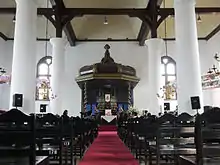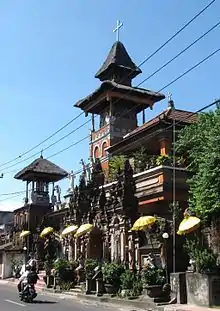Christianity in Indonesia
Christianity is Indonesia's second-largest religion, after Islam. Indonesia also has the second-largest Christian population in Southeast Asia after the Philippines, the largest Protestant population in Southeast Asia, and the third-largest Christian population in Asia after the Philippines and China, followed by India. Indonesia also has the second-largest Christian population in the Muslim world, after Nigeria, followed by Egypt.[3] Indonesia's 29,2 million Christians constituted 10,48% of the country's population in 2022, with 7,42% Protestant (20.7 million) and 3,06% Catholic (8.5 million).[4] Some provinces in Indonesia are majority Christian. In Indonesia, the word Kristen (lit. 'Christian') refers to Protestantism, while Catholicism is referred to as Katolik. In recent times, the rate of growth and spread of Christianity has increased, especially among the Chinese minority.[5][6][7]
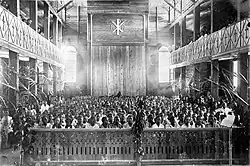 | |
| Total population | |
|---|---|
10.48% of the population. | |
| Regions with significant populations | |
| Majority New Guinea, East Nusa Tenggara, and North Sulawesi Significant Minority West Kalimantan, North Sumatra, Central Kalimantan, South Sulawesi, West Sulawesi, Central Sulawesi, North Maluku, Maluku (province) | |
| Scriptures | |
| Bible | |
| Languages | |
| Indonesian (official), English (international worship services), various regional languages |

| Christianity by country |
|---|
 |
|
|
Distribution
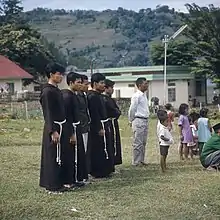
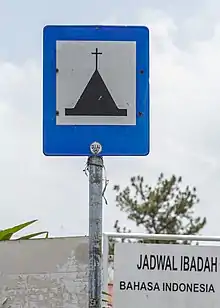
Christianity is not evenly spread throughout the archipelago. Eight Indonesian provinces that have a majority of the population identifying as Christian are Central Papua, Highland Papua, Papua, South Papua, Southwest Papua, West Papua, East Nusa Tenggara, and North Sulawesi.[8]
Christianity by Province in Indonesia 2018
| No | Province | Population 2018 |
Protestant % |
Catholic % |
Total % | |||||||||||||||||||||||||||||||||||||||||||||||||||||||||||||||||||||||||||||
|---|---|---|---|---|---|---|---|---|---|---|---|---|---|---|---|---|---|---|---|---|---|---|---|---|---|---|---|---|---|---|---|---|---|---|---|---|---|---|---|---|---|---|---|---|---|---|---|---|---|---|---|---|---|---|---|---|---|---|---|---|---|---|---|---|---|---|---|---|---|---|---|---|---|---|---|---|---|---|---|---|---|---|
| 1 | Aceh % |
5,253,512 100% |
64,300 1.22% |
5,101 0.10% |
69,401 1.32% | |||||||||||||||||||||||||||||||||||||||||||||||||||||||||||||||||||||||||||||
| 2 | North Sumatra % |
14,908,036 100% |
4,066,305 27.28% |
647,325 4.34% |
4,713,630 31.62% | |||||||||||||||||||||||||||||||||||||||||||||||||||||||||||||||||||||||||||||
| 3 | West Sumatra % |
5,542,994 100% |
80,812 1.46% |
46,246 0.84% |
127,058 2.30% | |||||||||||||||||||||||||||||||||||||||||||||||||||||||||||||||||||||||||||||
| 4 | Riau % |
6,149,692 100% |
581,673 9.46% |
63,430 1.03% |
645,103 10.49% | |||||||||||||||||||||||||||||||||||||||||||||||||||||||||||||||||||||||||||||
| 5 | Jambi % |
3,491,764 100% |
113,544 3.25% |
19,855 0.57% |
133,399 3.82% | |||||||||||||||||||||||||||||||||||||||||||||||||||||||||||||||||||||||||||||
| 6 | South Sumatra % |
8,030,200 100% |
79,965 0.97% |
49,643 0.60% |
129,068 1.57% | |||||||||||||||||||||||||||||||||||||||||||||||||||||||||||||||||||||||||||||
| 7 | Bengkulu % |
1,953,891 100% |
33,087 1.65% |
8,092 0.41% |
41,179 2.06% | |||||||||||||||||||||||||||||||||||||||||||||||||||||||||||||||||||||||||||||
| 8 | Lampung % |
8,675,884 100% |
129,162 1.43% |
82,941 0.92% |
212,103 2.35% | |||||||||||||||||||||||||||||||||||||||||||||||||||||||||||||||||||||||||||||
| 9 | Bangka Belitung % |
1,394,483 100% |
29,114 2.09% |
18,782 1.35% |
47,896 3.44% | |||||||||||||||||||||||||||||||||||||||||||||||||||||||||||||||||||||||||||||
| 10 | Riau Islands % |
1,961,388 100% |
234,745 11.97% |
47,678 2.42% |
282,423 14.40% | |||||||||||||||||||||||||||||||||||||||||||||||||||||||||||||||||||||||||||||
| 11 | Jakarta % |
11,011,862 100% |
945,089 8.58% |
432,086 3.92% |
1,377,175 12.50% | |||||||||||||||||||||||||||||||||||||||||||||||||||||||||||||||||||||||||||||
| 12 | West Java % |
45,632,714 100% |
833,418 1.83% |
293,613 0.64% |
1,127,031 2.47% | |||||||||||||||||||||||||||||||||||||||||||||||||||||||||||||||||||||||||||||
| 13 | Central Java % |
36,614,603 100% |
601,959 1.64% |
357,113 0.98% |
959,072 2.62% | |||||||||||||||||||||||||||||||||||||||||||||||||||||||||||||||||||||||||||||
| 14 | Yogyakarta % |
3,645,487 100% |
89,020 2.44% |
166,964 4.58% |
255,984 7.02% | |||||||||||||||||||||||||||||||||||||||||||||||||||||||||||||||||||||||||||||
| 15 | East Java % |
40,706,075 100% |
686,516 1.69% |
278,384 0.68% |
964,900 2.37% | |||||||||||||||||||||||||||||||||||||||||||||||||||||||||||||||||||||||||||||
| 16 | Banten % |
10,868,810 100% |
286,723 2.64% |
134,829 1.24% |
421,552 3.88% | |||||||||||||||||||||||||||||||||||||||||||||||||||||||||||||||||||||||||||||
| 17 | Bali % |
4,236,983 100% |
65,962 1.56% |
33,352 0.79% |
99,314 2.35% | |||||||||||||||||||||||||||||||||||||||||||||||||||||||||||||||||||||||||||||
| 18 | NTB % |
5,287,577 100% |
13,534 0.26% |
9,819 0.19% |
23,353 0.45% | |||||||||||||||||||||||||||||||||||||||||||||||||||||||||||||||||||||||||||||
| 19 | NTT % |
5,426,418 100% |
1,962,768 36.17% |
2,906,404 53.56% |
4,869,172 89.73% | |||||||||||||||||||||||||||||||||||||||||||||||||||||||||||||||||||||||||||||
| 20 | West Kalimantan % |
5,427,075 100% |
623,839 11.66% |
1,203,137 22.17% |
1,826,976 33.83% | |||||||||||||||||||||||||||||||||||||||||||||||||||||||||||||||||||||||||||||
| 21 | Central Kalimantan % |
2,577,215 100% |
429,481 16.67% |
81,420 3.16% |
510,901 19.83% | |||||||||||||||||||||||||||||||||||||||||||||||||||||||||||||||||||||||||||||
| 22 | South Kalimantan % |
4,042,565 100% |
53,689 1.33% |
21,421 0.53% |
75,110 1.86% | |||||||||||||||||||||||||||||||||||||||||||||||||||||||||||||||||||||||||||||
| 23 | East Kalimantan % |
3,612,106 100% |
275,706 7.63% |
156,565 4.34% |
432,301 11.97% | |||||||||||||||||||||||||||||||||||||||||||||||||||||||||||||||||||||||||||||
| 24 | North Kalimantan % |
645,118 100% |
133,424 20.68% |
38,957 6.04% |
172,381 26.72% | |||||||||||||||||||||||||||||||||||||||||||||||||||||||||||||||||||||||||||||
| 25 | North Sulawesi % |
2,645,118 100% |
1,673,635 63.27% |
116,895 4.42% |
1,790,530 67.69% | |||||||||||||||||||||||||||||||||||||||||||||||||||||||||||||||||||||||||||||
| 26 | Central Sulawesi % |
2,969,475 100% |
491,915 16.57% |
26,437 0.89% |
518,352 17.46% | |||||||||||||||||||||||||||||||||||||||||||||||||||||||||||||||||||||||||||||
| 27 | South Sulawesi % |
9,117,380 100% |
700,287 7.68% |
154,199 1.69% |
854,486 9.37% | |||||||||||||||||||||||||||||||||||||||||||||||||||||||||||||||||||||||||||||
| 28 | Southeast Sulawesi % |
2,632,939 100% |
44,906 1.71% |
16,070 0.61% |
60,976 2.32% | |||||||||||||||||||||||||||||||||||||||||||||||||||||||||||||||||||||||||||||
| 29 | Gorontalo % |
1,181,531 100% |
17,489 1.48% |
1,049 0.09% |
18,538 1.57% | |||||||||||||||||||||||||||||||||||||||||||||||||||||||||||||||||||||||||||||
| 30 | West Sulawesi % |
1,563,896 100% |
231,072 14.78% |
17,602 1.13% |
248,674 15.91% | |||||||||||||||||||||||||||||||||||||||||||||||||||||||||||||||||||||||||||||
| 31 | Maluku % |
1,854,229 100% |
729,181 39.33% |
126,638 6.83% |
855,819 46.16% | |||||||||||||||||||||||||||||||||||||||||||||||||||||||||||||||||||||||||||||
| 32 | North Maluku % |
1,314,849 100% |
322,498 24.53% |
6,470 0.49% |
328,968 25.02% | |||||||||||||||||||||||||||||||||||||||||||||||||||||||||||||||||||||||||||||
| 33 | West Papua % |
1,148,154 100% |
621,351 54.12% |
87,607 7.63% |
708,958 61.75% | |||||||||||||||||||||||||||||||||||||||||||||||||||||||||||||||||||||||||||||
| 34 | Papua % |
4,346,593 100% |
3,000,104 69.02% |
669,185 15.40% |
3,669,289 84.42% | |||||||||||||||||||||||||||||||||||||||||||||||||||||||||||||||||||||||||||||
| Indonesia % |
266,534,836 100% |
20,246,267 7.60% |
8,325,339 3.12% |
28,571,606 10.72% | ||||||||||||||||||||||||||||||||||||||||||||||||||||||||||||||||||||||||||||||
| Source:[4] | ||||||||||||||||||||||||||||||||||||||||||||||||||||||||||||||||||||||||||||||||||
Aceh
Among Indonesian provinces in 2018, Sumatra's northernmost province, Aceh, reported the fifth-smallest number of Christians (69,401) or 0.024% of Christians within Indonesia. Aceh had the second-smallest percentage (among religions reported in the province) of Christians (1.19%), effectively tying with Gorontalo for the smallest percentage of Catholics (0.07%) and including the third-smallest percentage of Protestants (1.12%).[9]
Aceh operates Sharia law and all regencies are 99%+ Muslim, with the exception of Aceh Singkil (11.2% Christian) and Southeast Aceh (18.7% Christian). Both areas' Christian populations consist of ethnic groups whose homelands lie outside Aceh—in Aceh Singkil, Christians are mostly Pakpak people, whose homeland is to the east of Aceh Singkil, in Pakpak Bharat Regency, of North Sumatra, as well as a small population of Nias people, on the Banyak Islands; in Southeast Aceh, the Christian population consists of Karo people, whose homeland lies to the south, in the Karo Regency of North Sumatra.
There are more than 100 churches, serving Southeast Aceh's 20,000 Christians, but the government of Aceh Singkil permits only one church and four chapels for its 10,000 Christians. As a result, there are approximately two dozen illegal churches in the regency, which the government periodically orders to be closed, and from time to time they are the subject of arson attacks, from extremist Muslim mobs.[10]
North Sumatra

Among Indonesian provinces in 2018, North Sumatra reported the second highest number of Christians (4.7 million) or 16.5% of Christians within Indonesia. North Sumatra had the seventh-highest percentage (among religions reported in the province) of Christians (31.6%), including the sixth-highest percentage of Protestants (27.3%), and 4.3% Catholic population.[11] However, this varies by regency—the Nias islands are 95%+ Christian of Nias ethnicity, and all of the areas surrounding Lake Toba have large Christian populations of the Batak Toba, Karo and Pakpak ethnic groups. Apart from this, most other parts of North Sumatra have a significant Christianity percentage (around 20 to 40%), with the exception of Langkat, in the northeast coast, Asahan on the east coast, and the Mandailing regencies in the south which are Muslim majority (below 10%).
South Sumatra
Among Indonesian provinces in 2018, South Sumatra reported the eleventh-smallest number of Christians (129,068) or 0.453625183% of Christians within Indonesia. South Sumatra had the third-smallest percentage (among religions reported in the province) of Christians (1.57%), including the second-smallest percentage of Protestants (0.97%) and eighth-smallest percentage of Catholics (0.6%).[11]
Remaining Sumatra Provinces
West Sumatra province (population 4.8 million) is another that is 99%+ Muslim in all areas, with the exception of the Mentawai Islands, whose 75,000 population is 80%, Christian. The province of Riau has a population of 5.5 million, which is 10% Christian, mainly of Batak ethnicity, and spread throughout the north side of the province, especially at Rokan Hilir Regency, Dumai, Duri and capital city Pekanbaru. The remaining provinces of Sumatra, all consist of 2–3% Christians. Only Batam (of the Riau Islands province), which is 20% Christian, has more than around 5% Christians of the regencies outside Aceh, Riau and North Sumatra.
Java
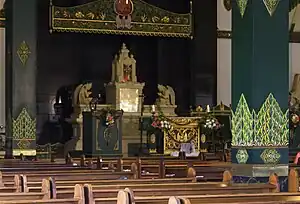

Banten, Java's westernmost province has 3.6% Christians out of 10 million people, who live almost entirely in Tangerang Regency, Tangerang city, and South Tangerang city. Jakarta has around 12.5% Christian population, of which 2/3 is Protestant and the remainder Catholic.[12] Christians are distributed all over Jakarta, with the exception of the Thousand Islands, which are nearly 100% Muslim. Christianity in Jakarta is linked to the Batak and Chinese population (which also is of the Buddhist faith), and the most Christian district, Kelapa Gading is 35% Christian due to its large Chinese population.
West Java province has only around one million Christians (of which three-quarters are Protestant) out of a population of 40 million. This population is concentrated in the cities of Bandung (7% Christian) and Bekasi (10% Christian).
The 32 million people of Central Java include 960,000 Christians, of which roughly 2/3 is Protestant. This population is again concentrated in cities, with Semarang 12% Christian, and Magelang, Salatiga and Surakarta exceeding 20% Christians.
The special region of Yogyakarta (population 3.5 million) is overall around 7.5% Christian, a population which is concentrated in Yogyakarta city and neighbouring Sleman. Yogyakarta's Christian population is around 2/3 Catholic.
East Java's population of 37.5 million includes 964,900 Christians (70% of which are Protestant). As with the rest of Java, this population is concentrated in the cities, with Surabaya's 2.8 million citizens more than 10% Christian, and Christian populations of around 8% in Mojokerto, Madiun, Kediri, Blitar and Malang.
The provinces of Java range from 5% Christian up to 12.5% in the capital, Jakarta.
Kalimantan
In Kalimantan, there are substantial (25–35%) Christian populations (mostly Dayak people) in West, Central, East, and North Kalimantan provinces, while in South Kalimantan the seafaring Banjar people are Muslims, and there is only a small (1–2%) Christian population.
West Kalimantan province has 1.8 million Christians of its 5.4 million population. This population is 2/3 Catholic. Coastal regions of West Kalimantan have a Muslim majority, as well as a significant Chinese Buddhist population, of up to 30% (in Singkawang city). Away from the coasts, there is overall a Christian majority, but in some areas, Muslims are in the majority. The 2.5 million population of Central Kalimantan includes 430,000 Protestants, and 81,400 Catholics. Most of the rest of the population is Muslim, but a significant (7%) proportion follows Kaharingan Dayak beliefs. The 3.6 million of South Kalimantan includes only 75,000 Christians. Of 3.6 million in East Kalimantan, 430,000 are Christian. There are Christian majorities in Malinau and Kutai Barat regencies. The remainder of the population is Muslim.
Bali
Compared with Java, and Sumatra, the dominant religion is not Islam, but Hinduism, with 86% of the population adherents. Christianity is a minor religion (<1%), with the exception of the Kuta districts (7–11%) of Badung regency, and Mengwi, Badung, which has 3% Christians. Denpasar city has 6% Christians.
West Nusa Tenggara
Among Indonesian provinces in 2018, West Nusa Tenggara had the smallest percentage (among religions reported in the province) of Christians (0.45%), including the smallest percentage of Protestants (0.26%) and third-smallest percentage of Catholics (0.19%). West Nusa Tenggara reported the second-smallest number of Christians (23,353) or 0.1% of Christians within Indonesia.[11] Slightly larger concentrations are found in Mataram, and Bima cites, both with just 2% Christians.
East Nusa Tenggara
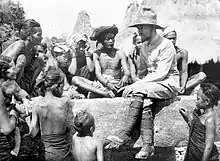
Among Indonesian provinces in 2018, East Nusa Tenggara had the highest percentage (among religions reported in the province) of Christians (89.73%), including the highest percentage of Catholics (53.56%) and the fifth-highest percentage of Protestants (36.17%). East Nusa Tenggara also reported the highest total number of Christians (4.8 million) or 17% of Christians within Indonesia.[11] The mix of religions and denominations varies significantly from area to area. Sumba island has a Catholic majority in Southwest Sumba Regency, but otherwise, Protestants outnumber Catholics five-to-one, in an island that is around 80% Christian, 15% animist, and 5% Muslim. West Timor is around 98% Christian, a population that is around 90% Catholic in the eastern two regencies, and 90% Protestant in the western regencies The Savu islands consist of 80% Protestants, with the balance practising traditional religion. The Rote islands are 95% Protestant, with Islamic and Catholic minorities. Pantar island has a population of 45,000 with a slight Islamic majority to the west, larger Protestant majorities to the east and central area. Neighbouring Alor island has similar demographics, with an Islamic majority in the extreme west, the rest of the island heavily Protestant, with a Catholic minority. Lembata island is 70% Catholic, with 27% Muslim, and just 2% Protestants. The main island of East Nusa Tenggara, Flores, has 1–2% Protestants throughout its area. The balance of the population is almost entirely Catholic with a Muslim minority that comprises around 20–25% in the far west, and the east, and under 10% in central area.
Sulawesi
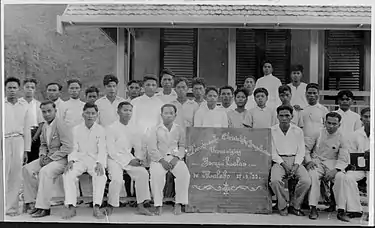
Among Indonesian provinces in 2018, North Sulawesi reported the fourth-highest number of Christians (1.54 million) or 6.3% of Christians within Indonesia. North Sulawesi had the third-highest percentage (among religions reported in the province) of Christians (68.01%), including the second-highest percentage of Protestants (63.6%) and 4.4% Catholic population.[9] North Sulawesi splits between a Protestant north/east, including the Sangihe, Sitaro and Talaud islands to the north and the entire Minahasa region, with an Islamic majority in Mongondow regencies. However, there are around 25% Christians in Mongondow, and around 15% Muslims in Minahasa (except for Manado city, which has 30%).
Gorontalo province is a stark contrast to its eastern neighbour, North Sulawesi. Among Indonesian provinces in 2018, Gorontalo reported the smallest number of Christians (18,538) or 0.07% of Christians within Indonesia. Gorontalo had the fourth-smallest percentage (among religions reported in the province) of Christians (1.57%), including the smallest percentage of Catholics (0.09%) and the seventh-smallest percentage of Protestants (1.58%).[11]
The region of Central Sulawesi is overall 17% Protestant; however, this ranges from 3% in Buol, to the west of North Sulawesi, up to 56%, in the central Poso Regency. Sigi Regency located to the west of Poso Regency also has a large Protestant population at 34%. Only in the Banggai islands (4%) has a Catholic population exceeding 1%.
West Sulawesi is predominantly Islamic along the coastal areas, but the interior Mamasa Regency, culturally part of the Toraja lands, is 75% Protestant.
The regencies of South Sulawesi are mostly Islamic (with many having a percentage of 99%+ Muslims); however, Tana Toraja and North Toraja regencies are 19% Catholic, and, respectively, 62% and 71% Protestant. In addition, the Luwu regencies and Palopo, to the north of Toraja, are around 15% Protestant. Makassar city has around 14% Christians, including 2% Catholics.[13]
Southeast Sulawesi regency has just around 2.3% Christians.
Maluku
Around 46% of the Southern Maluku's population is Christian. This population is overwhelmingly Protestant, except in the east, in the Kai, Tanimbar and Aru islands, which have Catholic populations. Only in the Kai islands is Catholicism the predominant denomination. In the northern province of North Maluku , 74.2% adheres to the Islamic religion while 25.4% adheres to Christianity (out of which 24.9% are Protestantism and 0.52% adheres to Catholicism ). Protestantism and Islam are otherwise unevenly distributed among the islands, with Ternate and Tidore 95% Islamic.
Papua
Among Indonesian provinces in 2018, Papua had the second-highest percentage (among religions reported in the province) of Christians (84.42%), the highest percentage of Protestants (69.02%), and 15.4% of residents reporting to be Catholic. This equates to 3.67 million Christians or 12.8% of Christians within Indonesia. In West Papua province, 54.12% of residents registered as Protestant and 7.63% of residents registered as Catholic, for a total of 61.75%. This equates to 708,958 Christians or 2.5% of Christians within Indonesia.[11]
Chinese Indonesians
Chinese Indonesians, in particular, have increasingly embraced Christianity. The 2000 census indicated that 35% of Chinese Indonesians designated themselves as Christian.[14][15] However, the Chinese Indonesian population in general was probably undercounted.[16] The percentage of Chinese Indonesians who belong to Christian churches continues to increase and may exceed 70 percent.[17]
Some reports also show that many of the Chinese Indonesians minority convert to Christianity.[18][17] Demographer Aris Ananta reported in 2008 that "anecdotal evidence suggests that more Buddhist Chinese have become Christians as they increased their standards of education".[6]
Bible translation
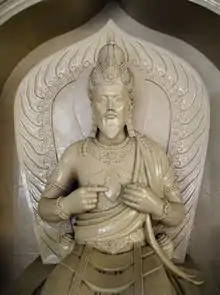
The first translation of the Bible ("Alkitab") in Indonesian language was Albert Corneliszoon Ruyl's translation of the book of Matthew (1629).[19][20] Between then and now at least 22 other translations exist, excluding the translations to local languages of Indonesia (out of more than 700 local languages of Indonesia, more than 100 languages have portions or whole Bible translated,[21] while some, like Javanese and Batak, have more than one version). In 1820, Gottlob Brückner (1783–1857) translated the Bible into Javanese, the most widely spoken language of Indonesia.[22]
Seminaries and schools
Before Indonesian independence, the only seminary was the theological seminary in Bogor.[23] This seminary was founded in 1934 as the Hoogere Theologische School (Higher School of Theology) and is now known as STT (Sekolah Tinggi Theologia) Jakarta.[24] As of 2002, Indonesia claimed more than 100 theological seminaries, with 29 seminaries representing 70% of students being members of PERSETIA (Association of Theological Schools in Indonesia). Other seminaries belong to PASTI (evangelical association) or PERSATPIM (Pentecostal association).[23]
History
Early history
According to Eastern Orthodox Indonesian Fr. Daniel Byantoro, Christianity in Indonesia dates back to the 7th century, when the country was dominated by the Hindu-Buddhist Srivijaya Empire.
In the Middle Ages, Nestorian Christianity was the first denomination of the religion to reach the Malay archipelago, brought over by Arab, Assyrian, and Persian traders who adhered to the Church of the East.
A 12th-century Christian Egyptian record of churches suggests that either an Oriental Orthodox or Nestorian church was established in Barus, on the west coast of North Sumatra, a trading post known to have been frequented by Indian traders, and therefore linked to the Indian Saint Thomas Christians.[25] When European travelers initially arrived in North Sumatra, they were surprised to see a church very similar to Roman Catholicism, and decided to convert the people there into Roman Catholics. No record nor trace of such a community remains, and the first significant evidence of Christian activity came with the arrival of Portuguese traders in the 16th century.
The Portuguese arrived in the Malacca Sultanate (modern-day Malaysia) in 1509 seeking access to its wealth. Although initially well-received, the capture of Goa in 1510 as well as other Muslim–Christian conflicts convinced the Malaccan Muslims that the Portuguese Christians would be a hostile presence. The resulting capture of Malacca in 1511 is believed to have enhanced a sense of Muslim solidarity against the Christian Portuguese, and ongoing resistance against the Portuguese came from Muslim Aceh as well as from the Ottoman Empire. Although the Portuguese built some churches in Portuguese Malacca itself, their evangelical influence in neighbouring territories was perhaps more negative than positive in promulgating Christianity.
Batavia (Jakarta)

As the centre for the VOC in the Indies, there were many European Christians as well as Asian Christians from areas proselytised by the Portuguese. The predominant denomination in Batavia was Dutch Reformed but there were also Lutherans and Catholics. The Dutch governors constructed Reformed churches, for Portuguese, Dutch and Malay speakers. Other religions were formally prohibited, but in practice, Chinese temples, as well as mosques, remained in existence, and despite various measures to promote Christianity, there was a high degree of religious diversity and never at any time a Christian majority. At other VOC settlements clergy were likewise provided, such as at Semarang, where the minister had a congregation that was only half Reformed and half Catholic or Lutheran and consequently efforts were made to provide inclusive preaching. Largely, however, the VOC had little impact or interest in upsetting their business interests in favour of religious ideas, and indeed the theology of the Dutch Reformed church was opposed to the mass baptism adopted by Catholic missionaries, and their impact on Java as a whole was very minor.[26]
The Batak mission

The largely mountainous 'Bataklands' of North Sumatra were surrounded to the north by the staunchly Islamic Acehnese, to the south by the Islamic Minangkabau and to the east by the Malays (also Muslims). The 'Bataks' were regarded by outsiders as a race of pagan cannibals, and it was largely their rejection of Islam that distinguished them from their neighbours. At the turn of the 19th century the southernmost Batak people, the Mandailing came, through their subjection in the Padri War, to follow Islam, rejecting traditional beliefs and, frequently, their identity as 'Batak'.[27]
Further north, however, Batak proved more resistant to the effect of Padri War campaigns, and receptive indeed to Christianity. The first missionaries were sent by Stamford Raffles in 1824, at which time Sumatra was under temporary British rule. They observed that the Batak seemed receptive to new religious thought, and were likely to fall to the first mission, either Islamic or Christian, to attempt conversion.[28]
A second mission that in 1834 of the American Board of Commissioners for Foreign Missions met with a brutal end when its two missionaries were killed by Batak resistant to outside interference in their traditional adat.
The first Christian community in North Sumatra was established in Sipirok, a community of (Batak) Angkola people. Three missionaries from an independent church in Ermelo, Netherlands arrived in 1857, and on 7 October 1861 one of the Ermelo missionaries united with the Rhenish Missionary Society, which had been recently expelled from Kalimantan as a result of the Banjarmasin War.
The mission was immensely successful, being well supported financially from Germany, and adopted effective evangelistic strategies led by Ludwig Ingwer Nommensen, who spent most of his life from 1862 until his death in 1918 in North Sumatra, successfully converting many among the Simalungun and Batak Toba as well as a minority of Angkola. Nommensen initially established Huta Dame, his 'village of peace', as Christian converts were excluded from their home villages, becoming knowledgeable in matters of Batak custom. Nommensen's success was supported by Peter Johannsen, who arrived in 1866, and has been praised for the quality of his Batak translations, as well as by respected Batak Raja Pontas, an early convert. Nommensen's theology saw Christianity as renewing rather than replacing traditional Batak customs, except in cases where adat were in direct contradiction to the Christian faith. The Batak Christian Protestant Church aka HKBP is the church that was formed from Nommensen's actions. To meet the desire for education, a seminary was established, along with elementary schools in Christian villages. By 1918, on Nommensen's death, his church comprised 180,000 members, with 34 ministers and 788 teachers/preachers. The distinct identity of Batak Toba people, separate from their Muslim neighbours, and their future role within Indonesia was thus assured.
As the process of decolonising continued following World Wars 1 and 2, the HKBP continued to grow, not just in the Tanah Batak, but also in Java and Medan, where many Bataks were seeking economic opportunities. The congregation grew 50% between 1951 and 1960, by which time it had reached 745,000. A growing disquiet at Toba 'imperialism' resulted in the establishment of the Gereja Kristen Protestan Simalungun and Gereja Kristen Protestan Angkola in the 1960s, both of which were expressions of a movement towards the native Simalungun and Angkola languages and traditions as against those of the Toba among their communities. In 1992, the Gereja Kristen Protestan Pakpak-Dairi, of the Pakpak-Dairi people was split from the HKBP.
While the traditional Batak church grew through rejecting only 'negative' adat, there is a more recent anti-adat movement among Pentecostalists that perceives non-Christian elements of Batak culture, such as ulos as satanic.
Karo Church
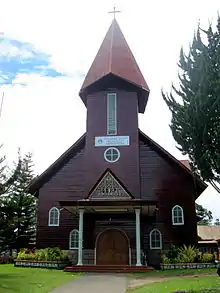
The (Batak) Karo people were harassing European interests in east Sumatra, and Jacob Theodoor Cremer, a Dutch administrator regarded evangelism as a means to suppress this activity. The Netherlands Missionary Society answered the call, commencing activities in the Karolands in 1890, where they engaged not only in evangelism but also in ethnology and documenting the Karo culture. The missionaries attempted to construct a base in Kabanjahe in the Karo highlands, but were repelled by the suspicious locals.[29]
In retaliation, the Dutch administration waged a war to conquer the Karolands, as part of their final consolidation of power in the Indies. The Karo perceived Christianity as the 'Dutch religion', and its followers as 'dark-skinned Dutch'. In this context, the Karo church was initially unsuccessful, and by 1950 the church had only 5,000 members. In the years following Indonesian independence the perception of Christianity among the Karo as an emblem of colonialism faded, with the church itself adopting more elements of traditional Karo culture such as music (previously the brass band was promoted), and by 1965 the Karo church had grown to some 35,000 members, with 60,000 baptised in 1966–1970.[30] At the same time, Islam was also being seen as increasingly attractive. From 5,000 Muslims (mostly non-Karo) in Karoland in 1950, there were 30,000 in 1970. Although the Gereja Batak Karo Protestan (GBKP) is the largest Karo church there are also Catholic (33,000 members as of 1986) and several Pentecostalist denominations.
The Rhenish Missionary Society
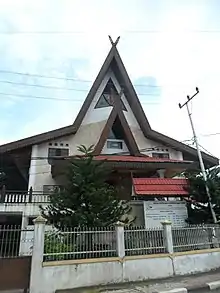
The German Rhenish Missionary Society visited Banjarmasin and West Kalimantan in 1829. Following this two missionaries were sent in 1834, and in total between 1834 and 1859 20 missionaries were sent to the region, although mortality rates were high and never more than 7 were active at one time. Permission for the activity from the Dutch government was obtained after 1836.[31]
Although the mission was headquartered in Banjarmasin, where the pastoral needs of European residents were supplied, it was apparent that converting the Muslims who dominate the cities of Kalimantan was an impossible task, and instead, efforts were focused on the Dayak people of the interior, who practised traditional religions. Johann Becker, a capable linguist, translated the gospels into the Dayak Ngaju language.
The missionaries also bought 1,100 Dayak slaves over the period 1836 to 1859 to emancipate them as free men. Despite their efforts, only a few hundred were baptised. In 1859 the Banjarmasin War broke out, several missionaries were killed, and the mission was excluded from the region until 1866 by the Dutch, which fought to bring the former Sultanate of Banjarmasin under direct rule.
In 1866 the missionaries returned. Despite building many mission stations and schools, only 3,000 had converted by 1911, as against 100,000 Batak Christians in the similarly resourced Rhenish mission of North Sumatra. It has been suggested that this slow progress was due to the fragmented nature of the Dayaks—with no king or dominant regional powers, there was little prospect of mass conversion, while new converts faced exclusion from their traditional ceremonies.
After World War I, the RMS was replaced by the Basel Mission. It transferred control to the first independent church, the 'Gereja Dayak Evangelis', in 1935, covering a vast geographical area from Banjarmasin 1,300 km to the west and 600 km inland. In 1950 the church became the more ethnically inclusive 'Gereja Kalimantan Evangelis' (GKE) as transmigrants from other parts of Indonesia to Kalimantan joined the congregation. The church has approximately 250,000 members, and is based in Central Kalimantan.[32]
Catholic Church
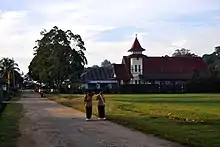
The Vatican agreed a Concordat with the Dutch in 1847 that Kalimantan was a possible mission area, provided they did not settle on rivers where other missionaries were already active.
Chinese, historically a major force in West Kalimantan, included among their number some Catholics, who had migrated from other parts of the region. The first church was consecrated in Singkawang in 1876, and from here in 1885 the post was established as a pastoral centre for the Jesuit priest who would be responsible for the area. A mission to the Dayaks of Sejiram was established in 1890, and a church[33] constructed. The Singkawang and Sejiram missions closed in 1896 and 1898, respectively, due to a lack of personnel.
The mission was re-established in Singkawang with Capuchin Friars in 1905. The first new missions (1905–1913) were aimed at the coastal Chinese of Pamangkat, Pontianak (location of West Kalimantan's Bishop, as it was the largest town in the region) and Sambas, as well as the deep Dayak interior, where the Catholics hoped to convert without competition from Islam, before working back towards the coast.
The Catholic training centre was established at Nyarumkop, close to Singkawang, where children (mostly Dayak, as the Chinese were less inclined towards Catholicism in West Kalimantan than in other parts of Indonesia – in 1980 only 3% of Chinese in West Kalimantan were Catholics) were educated and Catholic teachers trained.
Catholic growth prior to World War Two was slow, but subsequently saw some success, most notably after 1965 and the New Order (Indonesia), where all Indonesians were required to proclaim an approved religion. Growth in the Catholic population from 1950 to 2000 in the Roman Catholic Archdiocese of Pontianak was from 1.1% to 8.7%, in the Roman Catholic Diocese of Sintang from 1.7% to 20.1%. In the Roman Catholic Diocese of Sanggau, just over 50% of the population are now Catholic, while in the Roman Catholic Diocese of Ketapang it is around 20%. Catholic presence in East and South Kalimantan is much lower than the West Kalimantan Dioceses.
Christian and Missionary Alliance
Missionaries of the Christian and Missionary Alliance began one of several Indonesian missions in East Kalimantan in 1929 in the region of Kutai.[34] George Fisk, the lead missionary, asked only that new converts accept Jesus as their saviour, unlike the Catholics, who required two years of teaching. The West Kalimantan mission, established in 1933 in Pontianak ventured up the Kapuas River, where they found existing Catholic converts, some of whom converted to Protestantism. The Catholics, however, had an advantage over the CAMA Protestants in that CAMA, but not the Catholics, prohibited the consumption of alcohol.
The CAMA mission acted quickly in establishing churches in the interior, obtaining the use of an aeroplane from CAMA, and became part of the Kemah Injil Gereja Masehi Indonesia, or Tabernacle Gospel Messianic Indonesian church.
In 1990 the church had 98,000 members in East Kalimantan, and 62,000 in West Kalimantan, making it the third-largest Christian denomination in Kalimantan after the Catholic Church and the GKE.
Bali
Bali, unlike neighbouring Java, retained its Hindu culture when Islam came to the Indonesian archipelago, even gaining strength in this with the absorption of Javanese Hindus not wishing to convert to Islam. The Dutch began to build a presence on the island after 1846 in Singaraja, subduing it entirely in 1908. Three missionaries from the Protestant Utrecht Mission Society began work around Singaraja in 1864. Only one Balinese was baptised, and in 1881 following a disagreement, he conspired to have one of the missionaries murdered.[35][36]
Subsequently, the Dutch government forbade further missionary activity, wishing to avoid further such disruption. In 1930, a Chinese-speaking missionary from CAMA (see also above) obtained permission to work in Bali, to serve the needs of Chinese Christians. Several hundred native Balinese decided to convert. The reaction of the Hindu Balinese to the missionary's edicts – to destroy idols and temples as being of the devil – was hostile: the Christian converts had their rice fields sabotaged and they were expelled from their villages. As a result, the Dutch again withdrew permission to preach from foreign missionaries, as of 1933, on the basis that the missionary had not kept to the Chinese communities, but had also preached to the native Balinese.
A native Javanese missionary began work in Bali in 1933, and in 1937 the Dutch posted a minister to Denpasar of the Dutch 'Indische Kerk', catering for Europeans in the first instance, but also to the 1000+ Protestant Balinese, while a Catholic priest was posted to Denpasar in 1935, from where several hundred Balinese converts were made in several years.
A Dutch response to the hostility of the Balinese to Christian converts was to establish a Protestant village in Bali, that of Blimbingsari, in 1939. Palasari, its neighbour, a Catholic village, was established in 1940.
Blimbingsari village developed the Gereja Kristen Protestan Bali, the Balinese Protestant church, which was established in 1948. In its early years, the GKPB and its antecedent followed the theology of Hendrik Kraemer in the Dutch Reformed tradition, explicitly rejecting most of Balinese culture as heathen and unchristian, disposing of gamelan orchestras in favour of Western arts. As a result, many Balinese Protestants left Bali, where they were largely excluded from everyday Balinese life to the extent that there are more GKPB members outside of Bali than within Bali.
In 1972 native Balinese I Wayan Mastra, who grew up in a Balinese Hindu family, but converted to Christianity while at a Christian school in Java,[37] became head of the GKPB church and began a process of Balinisation. For instance, when the Blimbingsari church, a basic stone and wood building was destroyed by an earthquake in 1976, it was rebuilt in more Balinese pendopo style, with a garden with running water, traditional Balinese entrance and a semi-open aspect. Subsequent GKPB churches have followed a similar pattern. The Balinese Catholic church was from the beginning more open to Balinese traditions.
The Christian communities of Blimbingsari and Palasari[38][39] are the core of Balinese Christianity, with the religion very much in a minority in the rest of the island.
East Nusa Tenggara
Portuguese traders ventured from Malacca to Timor to purchase sandalwood. During their trading missions they were frequently becalmed, and during this time are said to have converted numerous people of Solor island, Timor and Flores. Hearing of these conversions, three Dominican missionaries were sent from Malacca, arriving and establishing a church in 1562 in Flores. The mission was given financial support from the Portuguese in Goa, enabling the construction of mission stations in the area.[40]
A major setback came when two headmen were imprisoned and mistreated by the Portuguese in 1598, resulting in a rebellion and desecration of churches throughout the region, as those opposed to the Portuguese, many of whom had been previously converted to Islam in the early 16th century, attacked the Portuguese and the Dominican mission. Subsequent setbacks came in the form of the arrival of the Dutch, who allied against the Portuguese Christians.
A new mission was established in 1617, which successfully furthered the spread of Catholicism in the region, including minor military ventures led from Larantuka on Flores, rejecting the dominions of Islamic Makassar. 'Black' Portuguese control over Larantuka, and influence also over Timor, was settled by a truce with the Dutch in 1661. The Catholic community in east Flores was strengthened by the expulsion of Catholics from Makassar in 1660. In Portuguese Timor the Portuguese mission at Lifau (which supported the nominal cathedral of the Diocese of Malacca, as the Dutch would no longer tolerate one there) was in conflict with the Dutch at Kupang, and wars were fought between the two sides with Catholic villages regarded as Portuguese and therefore enemies of the Dutch. In the first half of the 18th century 'Portuguese'-supporting factions were defeated entirely by the Dutch in West Timor, confining Catholicism to the eastern part of that island.
The Dominican mission declined in the late 18th century, and in 1817 the last priest covering Flores died. Many Catholics reverted to pagan practices, but still, thousands remained, continuing to follow Catholic pageantry. Portugal, severely weakened, withdrew from all but East Timor, but thanks to treaties signed in the 1850s, freedom of religion were guaranteed in areas being exchanged between the two countries. Following this treaty Catholicism strengthened considerably in Flores after 1860. In the western part of Flores, Dutch effective control over the area since 1907 led to the support of the spread of Catholicism among the Manggarai.[41][42]
Southern Sulawesi
The leaders of Makassar in southern Sulawesi expressed an interest in Christianity on several occasions in the 16th century, and while a request was made to Malacca for missionaries, none were forthcoming, perhaps because of the lack of commercial opportunities (spices) in the area. Initially reluctant towards Islam (which according to a contemporary Portuguese observer was partly due to a heavy reliance on pork meat in the basic diet), from 1605 the area converted to Islam, having received instruction in the faith from merchants from Johor who were rivals of the Portuguese. Subsequently, following the fall of Portuguese Malacca, many Catholics, including Jesuit priests, fled to Makassar, which was tolerant of their faith, but by 1660 the Dutch forced the expulsion of the Portuguese, who fled to Macau and Flores.[43]
Northern Sulawesi
The Portuguese baptised over a thousand in Manado, where the Portuguese, and Christianity, were seen as a bulwark against the powerful Ternate Sultanate directly due east. Portuguese missionary activity continued in northern Sulawesi between 1563 and 1570, but following the murder of Sultan Hairun in Ternate and the ensuing anti-Portuguese attacks, the mission was abandoned.[44]
In the Spanish-controlled Sangihe Islands and Talaud Islands in the kingdom of Siau, lying directly north of northern Sulawesi, Catholicism had been adopted with some enthusiasm, and when the allied Dutch-Ternatean Muslim pillaged the islands in 1613 and 1615, help was sought from the Philippines to the north. Franciscans visited from Manila, as did a Jesuit mission.
Jesuit missionaries were also active in Minahasa and neighbouring areas in the first half of the 17th century, but attacks from Muslims from Ternate as well as local animist peoples meant that priests had a short life expectancy. From 1655 to 1676 the Dutch established firm control of northern Sulawesi, and Catholicism was prohibited by the ruling VOC. With Catholicism harshly suppressed, as in Ambon in Maluku, the people of Minahasa, the Sangihe and Talaud islands are to this day almost entirely Protestant (the Dutch replacing the Catholic infrastructure with the schools of Dutch Protestantism), although in the 20th century fresh Catholic mission activity commenced.
Maluku
While the Portuguese religious influence over Malacca and Sumatra was very small, their mission to Maluku, the important spice islands of the eastern archipelago, was more significant. They landed first in Ambon, where the natives were already polarised into 'uli-lima' (group of five) and 'uli-siwa' (group of nine), the former having converted to Islam and allying with the Muslim Javanese, with the latter retaining traditional beliefs. The Portuguese found themselves allied with the ulu-siwa, whose opposition to the uli-lima made Christianity an appealing choice.[45]
The Islamic Sultanate of Ternate sought the patronage of the Portuguese, offering a trading monopoly in return for military support against rival local kingdoms. In 1534, the first Catholic community was established in Halmahera, the result of an appeal to the Portuguese for protection from Halmahera against Ternatean incursions—protection offered on condition of converting to Christianity.
Further evangelising resulted in many Ternate nobles converting to Christianity, while Francis Xavier, a Catholic missionary and co-founder of the Jesuit Order worked in Ternate, Moro and Ambon briefly in 1546 and also 1547. St Francis wrote that most of the population were 'pagan', and hated the local Muslims, resisting conversion to Islam. He appealed for support to save souls in Maluku, which arrived in 1547 in the shape of Nuno Ribeiro, a Jesuit who is said to have converted five hundred people before being murdered in 1549.
Sultan Hairun of Ternate had refused to convert to Christianity, regarding himself as a defender of the Islamic faith, and when he was murdered by a Portuguese Captain in 1570, his son, Baabullah, the new Sultan, reacted angrily, expelling the Portuguese from Maluku, waging war against both the Portuguese and their local Christian allies. As a result, the Jesuit mission was abandoned almost entirely in 1573, and Christians were killed or converted at the point of a sword. The faith survived only around the Jesuit fort in Ambon; even there, there was a shortage of priests due to dangerous conditions, and many local people did not have knowledge of Christian creeds and were easily apostatised to Islam or traditional beliefs.
The Portuguese by now largely impotent, the Dutch, allied with the Muslim locals against their mutual Portuguese enemy, seized the fort of Ambon in 1605. The Dutch expelled the Jesuits and Portuguese, adopting the Catholic churches for Protestant worship, which was supported through the establishment of numerous Protestant schools, where the teachers also led Sunday worship. Boundaries between Muslim and Christians were well-established on Ambon, but in Seram and Buru, proselytisation took place converting 'pagans' to Christianity, the policy of the VOC being to contain the spread of Islam without converting existing Muslims. Idols were destroyed by the Dutch teachers as new Christians were prohibited from continuing to follow their traditional religion.
Papua
Papua, unlike the rest of Indonesia, has had little historic contact with Muslim preachers, and had its first Christian missionary contact in 1855. With little competition, the mission was relatively successful. Missionaries Carl Ottow and Johann Geisler, under the initiative of Ottho Gerhard Heldring, entered Papua at Mansinam island, near Manokwari on 5 February 1855, and are said to have knelt on the beach and prayed, claiming Papua for Christ. Since 2001, the fifth of February has been a Papuan public holiday, recognising this first landing.[46]
Ottow and Geisler studied the Numfor language, and were subsequently granted a monthly stipend by the Dutch government. The missionaries proposed a scheme to start a tobacco plantation using Christian Javanese to train the Papuans and were given 5,000 guilders by the Dutch and two Christian Javanese tobacco farmers. The Dutch administrators perceived the missionaries activities as a cut-price means of colonisation, while the missionaries themselves made profits from trading Papuan goods. The Utrecht Mission Society (UZV) joined the mission in 1863; they were prohibited from trade, and instead established a trading committee.
The UZV established a Christian-based education system as well as regular church services. Initially, the Papuans' attendance was encouraged using bribes of betel nut and tobacco, but subsequently, this was stopped. In addition, slaves were bought to be raised as stepchildren and then freed. By 1880, only 20 Papuans had been baptised, including many freed slaves.
The Dutch government established posts in Netherlands New Guinea in 1898, a move welcomed by the missionaries, who saw orderly Dutch rule as the essential antidote to Papua paganism. Subsequently, the UZV mission had more success, with a mass conversion near Cenderawasih Bay in 1907 and the evangelisation of the Sentani people by Pamai, a native Papuan in the late 1920s. Due to the Great Depression, the mission suffered a funding shortfall and switched to native evangelists, who had the advantage of speaking the local language (rather than Malay) but were often poorly trained. The mission extended in the 1930s to Yos Sudarso Bay, and the UZV mission by 1934 had over 50,000 Christians, 90% of them in North Papua, the remainder in West Papua. By 1942 the mission had expanded to 300 schools in 300 congregations.
The first Catholic presence in Papua was in Fakfak, a Jesuit mission in 1894. In 1902 the Vicariate of Netherlands New Guinea was established. Despite the earlier activity in Fakfak, the Dutch restricted the Catholic Church to the southern part of the island, where they were active especially around Merauke. The mission campaigned against promiscuity and the destructive practices of headhunting among the Marind-anim. Following the 1918 flu pandemic, which killed one in five in the area, the Dutch government agreed to the establishment of model villages, based on European conditions, including wearing European clothes, but which the people would submit to only by violence.
In 1925 the Catholics sought to re-establish their mission in Fakfak; permission was granted in 1927. This brought the Catholics into conflict with the Protestants in North Papua, who suggested expanding to South Papua in retaliation. The Catholics and Protestants also began a race for the highlands.
After World War Two, New Guinea remained outside of Indonesian control, under the Dutch administration, but in 1963, it was absorbed under dubious circumstances into Indonesia. The Indonesians were suspicious of 'Dutch' elements, which included church teachers and missionaries, who had been educated in Dutch fashion and began an overnight Indonesianisation. Papua acquired a significant population of mostly Muslim transmigrants, who were given land and a house by the Indonesian government. Religious differences, as well as culture with the Muslim Indonesian army and administrators, have exacerbated the Papua conflict, in which thousands of Papuans have been killed by Indonesian security forces. Some human rights groups like the IWGIA estimate the number of killed Papuans to be over 100,000.[47] The majority of government resources were directed to non-Papuan Muslims rather than Papuan Christians, and non-Papuan Muslims were also given senior administrative roles. Church leaders, suspected of Papuan nationalism, were strictly monitored and in many cases killed where they strayed too close to Papuan separatist movements.
The 19th century

After the collapse of the VOC and defeat by the English, the Indies were eventually restored to the Dutch in 1815. By this time the separation of church and state had been established in The Netherlands. This meant that the presence of a Protestant monopoly in the Indies was abandoned, and in 1826 the Apostolic Prefecture of Batavia was established.[49]
As of 1800, there were an estimated 40,000 indigenous Protestants, in northern Sulawesi, central Maluku and Timor, as well as approximately 11,000 Catholics in east Flores and the islands around. This out of a population of a total 7 million represented just 0.7% Christians, against approximately 85% Muslims.[50] Thus it can be seen that in the last two centuries although the proportion of Muslims has remained largely constant in the archipelago, the Christian population has risen rapidly, thanks in large part to the 19th-century missionary societies, discussed below.
The 20th century
In 1941, there were 1.7 million Protestants and 600.000 Catholics in a population of 60 million.[51]
According to the World Christian Encyclopedia, between 1965 and 1985 about 2.5 million Indonesians converted from Islam to Christianity.[52] However, these statistics have been questioned and should be viewed in context.[53][54] In the 1960s due to anti-Communist and anti-Confucian legislation, many Communists and Chinese identified as Christians. Later, many Chinese Indonesian identified as Christian when the government discontinued recognition of Confucianism as an accepted religion.
According to the Ministry of Religious Affairs, 69,703 Christian churches operated throughout Indonesia in 2014. The 2006 joint ministerial decree provided Islamic groups with leverage to force closure of, or receive protection money from, churches without permits even if established before the decree. The Indonesian government failed to enforce the Supreme Court decisions permitting churches in Java to reopen.[8]
Violence and discrimination against Christians

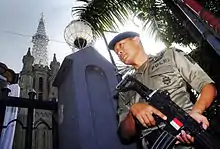
Forced circumcisions and forced conversions of Christians occurred during the 1999–2002 Muslim-Christian conflict in Maluku,[55][56] along with attacks on churches throughout Indonesia. The army, especially the special forces unit Kopassus, was accused of aiding the attacks in Maluku,[57][58] and the official response to these attacks was lacking, while the full force of the law was used against those Christians involved in revenge attacks. The 2006 execution of three Catholic citizens in Sulawesi nurtured further fears that the Indonesian state favoured Muslims while penalising the Christian minority.[59]
Even after the subsiding of the Maluku conflict, Christians are victims of a minor, but regular, attacks by radical Muslim organisations such as the Islamic Defenders Front (FPI).[60] In 2005, Indonesians were shocked by the beheadings of three Christian schoolgirls, perpetrated by Muslim extremists in Sulawesi.[61]
On 8 February 2011, trial spectators attacked the defendant, prosecutors and judges,[62] and Muslim rioters severely vandalised Protestant and Catholic churches, schools, and other property in Temanggung, Central Java in protest that prosecutors only demanded that the court sentence Antonius Bawengan to five years in prison (the maximum sentence permitted by law) for his alleged blasphemy against Islam via distributed leaflets.[63] A local Muslim cleric allegedly demanded that Antonius receive the death penalty. The judge immediately sentenced Antonius to five years in prison.[64] Local Muslim residents reportedly protected a Catholic priest and tried to minimise damage. The local Muslim cleric later received a one-year sentence for inciting the Temanggung riot.[65] The Temanggung riot occurred two days after 1,500 Sunni Muslims attacked Ahmadiyya Muslims in Cikeusik, Banten, murdering three.
On the other hand, and also in February 2011, a local FPI leader and followers each received at most a 5½-month sentence and were released based on time served after members of the group struck an HKBP pastor in the head with a wooden plank and stabbed an HKBP elder in the abdomen. The planned drive-by attack occurred in Bekasi, West Java while the victims were walking to a church service and related to local Muslims' objection to church construction. While local human rights activists expressed disappointment in the minimal sentences, no riots occurred.[66] Earlier, in 2010, hundreds of FPI members had attacked congregants during an HKBP church service in Bekasi, beating many women. Police were on-site but provided little protection.[67]
In early Ramadan in August 2011, a group of Muslims attacked and burned three churches in Kuantan, Senggingi, and Riau province. Police, not giving any reason for the burnings, said they were for the sake of keeping Ramadan peaceful for Muslims.[68]
Non-Muslims experience ongoing discrimination, including obstacles to university entrance and civil service jobs. A survey conducted in 2002 in Jakarta noted that 80% of respondents wanted faiths other than Islam outlawed, 73% wanted non-Muslims excluded from teaching in government schools, and 42% did not want churches constructed in their area.[69] Of particular concern to non-Muslim religious organisations, a 2006 joint ministerial decree on houses of worship (signed by the Religious Affairs Ministry and Home Ministry) requires a religious group to obtain the approval of at least 60 households in the immediate vicinity before building a house of worship. This decree has been used frequently to prevent the construction of non-Muslim places of worship and has been cited by radical Muslim organisations for various attacks on non-Muslims. but this decree has been used for keeping peaceful between neighbours so the people nearby newly built House of Worship is not provoked or disturbed by the presence of houses of worship in the area.[70]
On 9 May 2017, the Christian governor of Jakarta Basuki Tjahaja Purnama was sentenced to two years in prison by the North Jakarta District Court after being found guilty of committing a criminal act of blasphemy.[71]
On 13 May 2018 three churches were the target of suicide bombings in Surabaya.[72][73]
On 28 November 2020, about 10 people, allegedly from East Indonesia Mujahideen, killed four Christians and burning a Salvation Army post and Christians homes at Central Sulawesi, Indonesia.[74] Three of the victims were killed by getting their throats slit, and the other victim was killed by beheading.[75] On the other hand, Indonesian national police have denied that the attacks are religiously motivated, though the police vowed to begin pursuit of the perpetrators.[76]
Diaspora
A number of Indonesian Christians have fled persecution since 1998 reformation riot, forming a sizable diaspora abroad, in countries including the United States.[77][78]
In 2010, the U.S. Court of Appeals for the Ninth Circuit, for purposes of U.S. immigration law: "[T]he record compels a finding that Christians in Indonesia are a disfavored group".[79][80] The definition of this term is "a group of individuals in a certain country or part of a country, all of whom share a common, protected characteristic, many of whom are mistreated, and a substantial number of whom are persecuted" but who are "not threatened by a pattern or practice of systematic persecution." The court blamed the rise of anti-Christian sentiment on Suharto consorting with militant Islamic groups in the 1990s in order to maintain his power, noting that he had "purged his cabinet and army of Christians and replaced them with fundamentalist Muslims", and adding that support and protection for violent Islamic militia such as Laskar Jihad by the military and political elite had continued since Suharto's exit from power. According to the ruling: "Christian churches throughout Indonesia have been burned, bombed, and vandalised by Muslim extremists. These attacks are often accompanied by threats, such as: 'God has no son. Jesus could not help you. Until doomsday, Muslims will not make peace with Christians. Death to all Christians.'"
Christian population growth
- Indonesia is home to the largest Christian community made up of converts from their former Islamic faith; according to various sources, since the mid and late 1960s, between two million to 2.5 million Muslims converted to Christianity.[81][82][83][84][85][86]
- According to the World Christian Encyclopedia, between 1965 and 1985 about 2.5 million Indonesian converted from Islam to Christianity.[52]
- According to Believers in Christ from a Muslim Background: A Global Census study found that between 1960 and 2015 about 6.5 million Indonesian Muslims convert to Christianity.[87]
- Some reports also show that many of the Chinese Indonesians minority convert to Christianity.[88][89][90][91][92] Demographer Aris Ananta reported in 2008 that "anecdotal evidence suggests that more Buddhist Chinese have become Christians as they increased their standards of education" he says that "Christianity is often associated with 'modernity' and Western education. Buddhism is associated with Chinese traditional ways,".[18] According to scholar Gavin W. Jones of Australian National University, "there has been a rapid growth in the number of Chinese Christians" in Indonesia, and "conversion of Chinese to Christianity accelerated in the 1960s, especially in East Java, and for Indonesia as a whole the proportion of Chinese who were Catholics rose from 2 percent in 1957 to 6 percent in 1969".[93]
See also
References
- "Statistik Umat Menurut Agama di Indonesia" (in Indonesian). Kementerian Agama Republik Indonesia. 30 June 2023. Archived from the original on 3 September 2020. Retrieved 19 June 2023.
Muslim 231.069.932 (83.19), Christian 20.722.154(7.42), Catholic 8.542.284 (3.06), Hindu 4.692.548 (1.74), Buddhist 1.693.833 (0.77), Confucianism 74.899 (0.03), Others/Traditional faiths 117.412 (0.04), Total 277.749.853
- Aris Ananta, Evi Nurvidya Arifin, M Sairi Hasbullah, Nur Budi Handayani, Agus Pramono. Demography of Indonesia's Ethnicity. Singapore: ISEAS: Institute of Southeast Asian Studies, 2015. p. 273.
- "Visualisasi Data Kependudukan". gis.dukcapil.kemendagri.go.id. Retrieved 19 June 2023.
- "Statistik Umat Menurut Agama di Indonesia" (in Indonesian). Kementerian Agama Republik Indonesia. 15 May 2018. Archived from the original on 3 September 2020. Retrieved 15 November 2020.
Muslim 231.069.932 (86.7), Christian 20.246.267 (7.6), Catholic 8.325.339 (3.12), Hindu 4.646.357 (1.74), Buddhist 2.062.150 (0.77), Confucianism 71.999 (0.03), Others/Traditional faiths 112.792 (0.04), Total 266.534.836
- Brazier, Roderick (27 April 2006). "Opinion | In Indonesia, the Chinese go to church". The New York Times. ISSN 0362-4331. Retrieved 28 April 2021.
- "In Indonesia, Lunar New Year an old practice for young Christians". Agence France-Presse. 7 February 2008. Archived from the original on 28 November 2011. Retrieved 15 August 2011.
- "(PDF) Believers in Christ from a Muslim Background: A Global Census | Duane A Miller - Academia.edu". 28 September 2019. Archived from the original on 28 September 2019. Retrieved 28 April 2021.
- International Religious Freedom Report for 2014, Indonesia, U.S. Department of State, Bureau of Democracy, Human Rights and Labor, 2014, retrieved 28 December 2015
- "Penduduk Menurut Wilayah dan Agama yang Dianut" [Population by Region and Religion]. Sensus Penduduk 2010. Jakarta, Indonesia: Badan Pusat Statistik. 15 May 2010. Retrieved 20 November 2011.
Religion is belief in Almighty God that must be possessed by every human being. Religion can be divided into Muslim, Christian, Catholic, Hindu, Buddhist, Hu Khong Chu, and Other Religion.
Moslem 207176162 (87.18%), Christian 16528513 (6.96%), Catholic 6907873 (2.91%), Hindu 4012116 (1.69%), Buddhist 1703254 (0.72%), Khong Hu Chu 117091 (0.05%), Other 299617 (0.13%), Not Stated 139582 (0.06%), Not Asked 757118 (0.32%), Total 237641326 - "One killed in Aceh church clashes". BBC News. 14 October 2015.
- "2018 Census totals by topic – national highlights | Stats NZ". www.stats.govt.nz. Archived from the original on 23 September 2019. Retrieved 5 January 2020.
- "Peringatan".
- Provinsi Sulawesi Selatan Dalam Angka 2020, p. 271. Makassar: BPS-Statistics of Sulawesi Selatan Province.
- "The population of Chinese Indonesians and Chinese Christians in the Sulawesi provinces and the cities of Medan and Banda Aceh; incidents of violence and state protection available (2006 to March 2010)". Responses to Information Requests. Ottawa, Ontario: The Immigration and Refugee Board of Canada. 17 March 2010. IDN103410.E. Archived from the original on 4 August 2012. Retrieved 15 February 2012.
[A]ccording to the 2000 census, 35.09 percent of Chinese Indonesians throughout Indonesia are Christian.
Cites omitted - "Situation of ethnic Chinese Christians in Indonesia (2001–2003)". Responses to Information Requests. Ottawa, Ontario: The Immigration and Refugee Board of Canada. 9 December 2003. IDN42199.E. Archived from the original on 5 September 2012. Retrieved 15 February 2012.
Approximately three per cent of Indonesia's population is ethnic Chinese [], most of whom are Christians[.]
- "The largest centres of Chinese Indonesian population; reports of attacks in these areas and protection available; whether some areas of Indonesia are considered more welcoming than others to Chinese Indonesians (2004–2006)". Responses to Information Requests. Ottawa, Ontario: The Immigration and Refugee Board of Canada. 29 March 2006. IDN101031.E. Archived from the original on 5 September 2012. Retrieved 15 February 2012.
The 2000 census, however, does provide information on ethnicity, although the data on Chinese Indonesians is "severely flawed," ***. In the 2000 census, many Chinese Indonesians reportedly did not self-identify due to fears related to the 1998 race riots ***. [Professor] Mackie stated that, "whether the non-reporting Chinese numbered only a small proportion or vastly more in any region, or nationally, is quite unknown and unknowable"
Cites omitted. - Brazier, Roderick (27 April 2006). "In Indonesia, the Chinese go to church". International Herald Tribune. Retrieved 27 January 2010.
Of the estimated five million ethnic Chinese in Indonesia, well over 70 percent are now Christian.
- "In Indonesia, Lunar New Year an old practice for young Christians". Agence France-Presse. 7 February 2008. Archived from the original on 28 November 2011. Retrieved 15 August 2011.
- (in Indonesian) Sejarah Alkitab Indonesia / Ruyl
- (in Indonesian) Timeline of Bible translation in the Indonesian Language
- (in Indonesian) List of local languages of Indonesia with Bible translations
- Timeline of Bible translation in local languages of Indonesia
- Borrong, Robert P.; Ngelow, Zakaria J. (October 2002). Breeding the Peace Bearers: The (Protestant) Christian Higher Education In Indonesia. Manila Leadership Conference. International Association for the Promotion of Christian Higher Education. Archived from the original on 19 April 2012. Retrieved 21 March 2012.
- Aritonang, Jan S.; Steenbrink, Karel A. (2008). A history of Christianity in Indonesia. Studies in Christian mission. Vol. 35. BRILL. p. 825. ISBN 978-90-04-17026-1. Retrieved 21 March 2012.
- Adolf Heuken. Ensiklopedi Gereja (2005). See Also Adolf Heuken, "Chapter One: Christianity in Pre-Colonial Indonesia", in A History of Christianity in Indonesia, eds. Jan Aritonang and Karel Steenbrink, pgs. 3–7, Leiden/Boston: Brill, 2008, ISBN 978-90-04-17026-1
- History of Christianity in Indonesia. pp. 121–132
- History of Christianity in Indonesia. pp. 527–569
- History of Christianity in Indonesia p. 530
- History of Christianity in Indonesia. pp. 569–584
- History of Christianity in Indonesia p576
- History of Christianity in Indonesia. Chapter 12
- "Kalimantan Evangelical Church". Archived from the original on 5 April 2012. Retrieved 19 April 2022.
- "The Site of Gereja Katolik Santo Fidelis Sejiram". 11 May 2010.
- "Gereja Kemah Injil Indonesia". www.reformiert-online.net.
- History of Christianity in Indonesia. Chapter Fifteen
- Seeking the Asian Face of Jesus – Chris Sudgen
- Seeking the Asian Face of Jesus – Chris Sudgen; p. 42
- "Blimbingsari & Palasari – Christian communities in west Bali". Archived from the original on 16 July 2011. Retrieved 19 April 2022.
- The Star: Beatific Blimbingsari, 24 March 2007.
- History of Christianity in Indonesia. Chapter Four
- Steenbrink, Karel (2007). Catholics in Indonesia, 1808–1942: A Documented History. Volume 2: The Spectacular Growth of a Self Confident Minority, 1903–1942. Verhandelingen Van Het Koninklijk Instituut Voor Taal-, Land- En Volkenkunde. ISBN 9789004254022.
- The Mission of Development: Religion and Techno-Politics in Asia. Verhandelingen Van Het Koninklijk Instituut Voor Taal-, Land- En Volkenkunde. 2018. ISBN 9789004363106.
- History of Christianity in Indonesia. pp. 59–62
- History of Christianity in Indonesia. pp. 62–68
- History of Christianity in Indonesia. Chapters 3 and 5
- A History of Christianity in Indonesia – Chapter 8
- IWGIA: The Indigenous World 2006, p. 266 (online Archived 3 September 2010 at the Wayback Machine)
- Gonggong 2012, p. 138.
- "Archdiocese of Jakarta, Indonesia".
- History of Christianity in Indonesia p141
- Encyclopedia of Protestantism: 4-volume set by Hans J. Hillerbrand
- David B. Barrett; George Thomas Kurian; Todd M. Johnson, eds. (15 February 2001). World Christian Encyclopedia p.374. Oxford University Press USA. ISBN 0195079639.
- Miller, Duane Alexander; Johnstone, Patrick (2015). "Believers in Christ from a Muslim Background". Interdisciplinary Journal of Research on Religion. Waco, TX: Baylor University. 11. ISSN 1556-3723. Retrieved 23 June 2016.
[A]ccurately estimating the number of such converts is very difficult [...] In Indonesia, a great number of new converts to Christianity occurred among the non-Muslim peoples of Indonesia and to an extent among the 'folk' Muslim East Javanese. The failed Communist coup of 1965, the subsequent massacres of supposed supporters of that coup by Muslims, and legislation that required all Indonesians to sign up for one of the five official religions of the country led to a huge turning to the Christian churches for refuge and engendered disgust for the cruelties perpetrated in the name of Islam.
- Narciso, Jerson Benia (24 March 2008). "Christianization in New Order Indonesia (1965–1998)". Melintas. Bandung, Indonesia: Parahyangan Catholic University. 24 (3): 407–428. ISSN 0852-0089. OCLC 45613609. Retrieved 23 June 2016.
[T]he massive religious conversion of 1965 and onward should be understood against the backdrop of government pressures and policies which required all citizens to embrace an official religion. They also observe that some Indonesians decided to become Christian because they felt there had been too much tension between Islam and communism. Christianity perhaps was the least risky option.
- International Religious Freedom Report 2001
- Karel Steenbrink/Mesakh Tapilatu (2008), Moluccan Christianity in the 19th and 20th century between Agama Ambon and Islam, in: Jan Sihar Aritonang/Karel Steenbrink (eds.), A history of Christianity in Indonesia. Leiden: Brill, p. 414
- The Age: We must not get back in bed with Kopassus, 14 August 2003
- The Age: After the Bali cocoon falls away, 25 September 2003
- "Executions spark Indonesia unrest". BBC News. 22 September 2006.
- International Religious Freedom Report 2007, 2008, and 2009
- "Indonesia beheadings trial opens". BBC News. 8 November 2006.
- "Violence at blasphemy trial in Central Java". The Jakarta Post. 8 February 2011. Archived from the original on 4 March 2016. Retrieved 16 July 2011.
- "Mobs destroy 3 churches in C. Java". The Jakarta Post. 8 February 2011. Archived from the original on 4 March 2016. Retrieved 8 February 2011.
- Maryono, Agus (10 February 2011). "Mixed response for blasphemy verdict". The Jakarta Post.
- "Temanggung riot inciter gets 1 year". The Jakarta Post. 15 June 2011.
- Tampubolon, Hans David (25 February 2011). "FPI leader gets less than six months for church attack". The Jakarta Post. Jakarta. Retrieved 15 July 2011.
- "FPI attacks HKBP church members in Bekasi". The Jakarta Post. 8 August 2010.
- "Polda Riau Tolak Beberkan Motif Pembakaran Gereja GPdI, GBKP dan GMI di Kuantan Sengingi". Kabar Gereja. 13 August 2011. Archived from the original on 8 September 2011. Retrieved 15 August 2011.
- http://www.asylumlaw.org/docs/indonesia/IDO_1/IDO1/Section%20II/Many%20Muslims%20Want.pdf
- "HKBP followers demand revocation of a controversial decree". The Jakarta Post. 16 September 2010. Archived from the original on 6 May 2015. Retrieved 16 July 2011.
- Lamb, Kate (9 May 2017). "Jakarta governor Ahok found guilty of blasphemy, jailed for two years". The Guardian.
- Suhartono, Muktita; Callimachi, Rukmini (13 May 2018). "Indonesia Church Bombings Carried Out by Family With Children in Tow". The New York Times.
- "Family of bombers 'had been to Syria'". BBC News. 14 May 2018.
- "Perintah Kapolri: Tembak Mati Teroris MIT Ali Kalora! | Kabar24". Bisnis.com. 30 November 2020. Retrieved 1 December 2020.
- "Suspected terrorists kill 4 Christians, burn church members' homes after attack on Salvation Army's service post". www.christianpost.com. 28 November 2020. Retrieved 29 November 2020.
- Widianto, Nilufar Rizki, Stanley (28 November 2020). "Indonesia police hunt suspected militants after four killed on island". Reuters. Retrieved 29 November 2020.
{{cite news}}: CS1 maint: multiple names: authors list (link) - Phelim Kine, Why Indonesia's Christian Diaspora Fears Going Home, East Asia Forum (1 March 2018).
- Tom Gjelten, After Fleeing Persecution, U.S. Christian Refugees Now Face Deportation, NPR (8 July 2017).
- Tampubolon v. Holder, 610 F.3d 1056, 1058 (9th Cir. 9 March 2010).
- "RIORI TAMPUBOLON; ERLINDA SILITONGA, Petitioners, v. ERIC H. HOLDER JR., Attorney General, Respondent" (PDF). 4 February 2010. Retrieved 20 April 2022.
- Anderson, Allan (2013). An Introduction to Pentecostalism: Global Charismatic Christianity. Cambridge University Press. p. 145. ISBN 9781107033993.
estimated that over 2 million Javanese Muslims became Christians between 1965 and 1971, and Pentecostal churches gained the most members
- Samuel Shah, Timothy (2016). Christianity and Freedom: Volume 2, Contemporary Perspectives. Cambridge University Press. ISBN 9781316565247.
Between 1966 and 1976, some 2 million ethnic Javanese from nominally Islamic backgrounds converted to Christianity
- Bresnan, John (2005). Indonesia: The Great Transition. Rowman & Littlefield. p. 107. ISBN 9780742540118.
Between 1966 and 1976, almost 2 million ethnic Javanese, most from nominally Islamic backgrounds, converted to Christianity. Another 250,000 to 400,000 became Hindu.
- P. Daniels, Timothy (2017). Sharia Dynamics: Islamic Law and Sociopolitical Processes. Springer. p. 102. ISBN 9783319456928.
almost two million nominal Muslims to convert to Christianity
- Madan, T. N. (2011). Sociological Traditions: Methods and Perspectives in the Sociology of India. SAGE Publications India. p. 53. ISBN 9788132107699.
Simultaneously, a considerable number of muslims (about 2 million) converted to Christianity and Hinduism, a most unique event.
- L. Berger, Peter (2018). The Limits Of Social Cohesion: Conflict And Mediation In Pluralist Societies. Routledge. p. 53. ISBN 9780429975950.
Some 2 million nominally Islamic Javanese reacted against the violence of their Muslim brethren by converting to Christianity.
- Miller, Duane A. "Believers in Christ from a Muslim Background: A Global Census" – via academia.edu.
- "In Indonesia, Lunar New Year an old practice for young Christians". Archived from the original on 28 November 2011. Retrieved 15 August 2011.
- Brazier, Roderick (27 April 2006). "Opinion | In Indonesia, the Chinese go to church (Published 2006)". The New York Times.
- "AFP: In Indonesia, Lunar New Year an old practice for young Christians". 10 February 2008. Archived from the original on 10 February 2008.
- Brazier, Roderick (27 April 2006). "In Indonesia, the Chinese go to church". The New York Times.
- "Religion and Education in Indonesia" (PDF). Gavin W. Jones. 30 January 2017.
Finally, during this century there has been a rapid growth in the number of Chinese Christians. Very few Chinese were Christians at the turn of the century. Today Christians constitute approximately 10 or 15 percent of the Chinese population in Indonesia, and probably a higher percentage among the young. Conversion of Chinese to Christianity accelerated in the 1960s, especially in East Java, and for Indonesia as a whole the proportion of Chinese who were Catholics rose from 2 percent in 1957 to 6 percent in 19.
- "Religion and Education in Indonesia" (PDF). Gavin W. Jones. 30 January 2017.
P.25: Finally, during this century there has been a rapid growth in the number of Chinese Christians. Very few Chinese were Christians at the turn of the century. 22 Christians today make up roughly 10 or 15 percent of the Chinese population in Indonesia, 23 and perhaps a higher proportion among the young. The conversion of Chinese to Christianity accelerated in the 1960s, particularly in East Java, and for Indonesia as a whole, the proportion of Chinese who were Catholic rose from 2 percent in 1957 to 6 percent in 1969 (24). locally born) Chinese. This growth appears to be a response to intense missionary efforts and a search for acceptance and identity in Indonesian society through the adoption of a more acceptable and less "Chinese" religion25 which at the same time removes suspicion of sympathy with the communists.
Bibliography
- Gonggong, Anhar (2012). Mgr. Albertus Soegijapranata SJ: Antara Gereja dan Negara [Mgr. Albertus Soegijapranata SJ: Between the Church and the State] (in Indonesian) (Revised ed.). Jakarta: Grasindo. ISBN 978-979-081-803-3.
- Jan Sihar Aritonang; Karel Adriaan Steenbrink (2008). A History of Christianity in Indonesia. BRILL. ISBN 978-90-04-17026-1.
